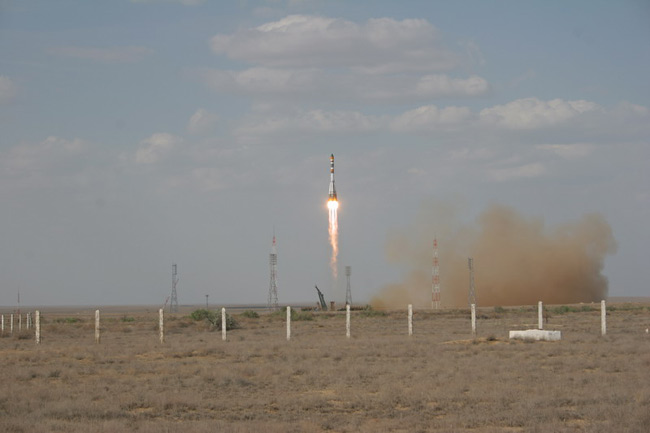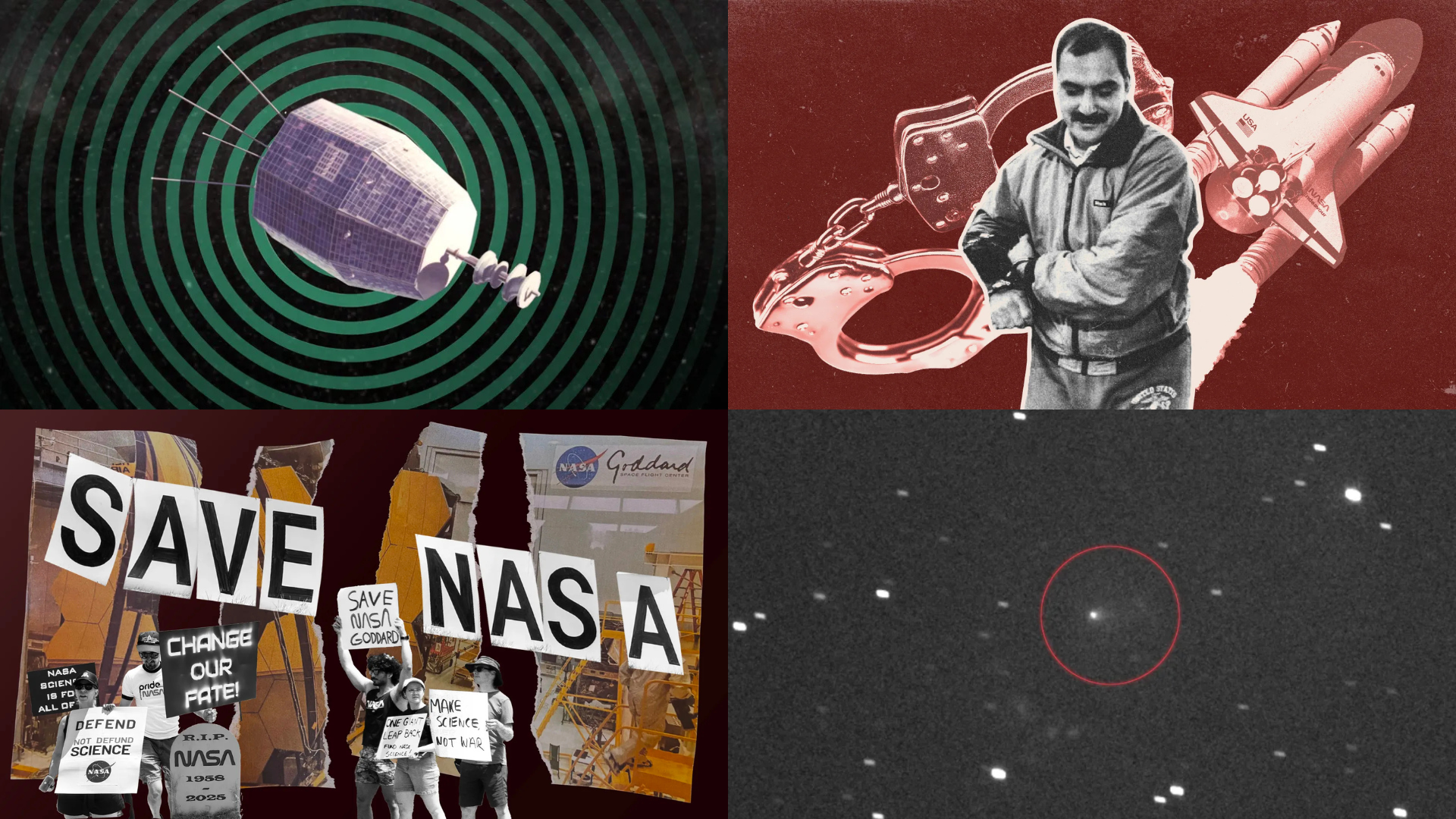Lost Experiments Fly Again in Successful Soyuz Launch

A diverse suite of scienceexperiments from around the world is now in orbit after a flawless launchaboard a Russian Soyuz rocket. The Foton microgravity research capsule isembarking on a 16-day mission in space before returning to Earth in mid-June.
The unmanned Foton-M2 craftlifted off on the Soyuz at 1200 GMT (8 a.m. EDT) from launch complex 2 at theBaikonur Cosmodrome in Kazakhstan. Nine minutes later, the three-stage rocketplaced the spacecraft into the expected orbit with an apogee, or high point, ofabout 189 miles, a perigee of around 163 miles, and an inclination of 63degrees.
The mission carries a widearray of over three dozen experiments in a variety of fields including physicalsciences, biology, fluid mechanics, exobiology, materials sciences, andtechnology demonstrations. The 1,200-pound payload largely comes from Europeannations.
Many of the scientificinvestigations finding their way to space aboard the Foton are being reflownafter their Foton-M1 capsule was destroyed when its Soyuz booster explodedseconds after liftoff in October 2002. All the experiments on the failed flightare on this mission with the exception of a French biological incubator and afew student experiments, European Space Agency Foton project manager AntonioVerga told Spaceflight Now.
An applicable technologydemonstration called Favorite - for Fixed Alkaline Vapor Oxygen ReclamationIn-flight Technology Experiment - will test a new way to generate oxygen fromwater molecules.
Called electrolysis, theprocess splits hydrogen and oxygen elements from water molecules to be used forbreathing aboard manned spacecraft such as the international space station. Thetwo-man crew on the station normally relies on a Russian Elektron system, butthat unit recently malfunctioned, leaving the astronauts to use a backup methodthat produces oxygen through the burning of solid-fuel "candles."
The Favorite hardwareriding in the Foton capsule is a newly developed design from Europe that"does not contain moving parts, making it inherently simpler and morereliable," according to an ESA fact sheet. The system is planned tooperate for about 40 hours near the end of the flight and is expected toproduce 13 liters of oxygen per hour from an average energy usage of about 290watts. This amount of breathable oxygen is enough to supply half an astronaut.
Breaking space news, the latest updates on rocket launches, skywatching events and more!
An experiment originallyflown aboard Columbia's ill-fated mission in 2003 was also launched into spaceaboard the Foton capsule. This effort deals will heat pipes for thermal controlsystems on future spacecraft.
The largest of the payloadsis an automatic fluid physics facility containing four individual experiments.At 390 pounds, FluidPac comprises almost half the internal volume of theFoton's entry module.
A 59-pound exposureexperiment housed on the outside of the entry capsule called Biopan contains anumber of organic samples such as bacteria and fungi cells. Other bacterialspores will be placed in a simulated environment similar to that on the surfaceof Mars to evaluate their performance in such harsh conditions.
Several re-entryexperiments will test new reusable heat shield technologies made of a ceramiccomposite material and how the high temperature affects organic compounds likeamino acids and rocks containing imbedded microbes.
In addition, a precursorexperiment for a future ESA research facility to fly on the international spacestation carries two scorpions to space to test the affects on the animals ofthe launch vibrations and fiery re-entry into the atmosphere.
Other components of theFoton's science complement will examine how crystals grow in space, analyze thebehavior of molten metal alloys in weightlessness, and show how single-cellwater organisms react to space.
A small capsule known asFotino had been slated to be riding as a piggyback payload on the launch, butthe small student-built sphere was removed due to inadequate funding. Developedby 100 European students, Fotino was supposed to be released by the Fotonbefore entering the Earth's atmosphere to test a number of inexpensivetechnologies in advance of the larger Young Engineers Satellite-2 mission.
The next Foton flight in2006 will carry YES2 to demonstrate a tether-based inflatable entry vehiclethat uses no rocket engines or parachutes.
Control stations around theworld will oversee the Foton mission, ranging from an engineering support roomin mission control in Korolev outside Moscow to a European scientificoperations center in Sweden.
The 14,000-pound Foton-M2spacecraft will orbit Earth for almost 16 days before its scheduled re-entryand landing on June 16 at 0832 GMT (4:32 a.m. EDT). The entry module containingthe experiments will make a parachuted landing near the city of Orenburg,Russia, near the Kazakhstan border.
This mission marks the 11thtime the European Space Agency has significantly participated in flightsinvolving the Foton capsule and its predecessor called Bion dating back to1987. The Foton's design is based on the Russian Vostok craft that cosmonautpioneer Yuri Gagarin rode to and from orbit in the first human spaceflight in1961.
Russia flew twelve Fotonmissions 1985 through 1999, followed three years later by the botched Foton-M1launch. The Foton-M craft features several improvements over earlier capsulessuch as a larger battery capacity to allow larger payloads with higher powerconsumption.
Previous Foton flights hadlaunched from the Plesetsk Cosmodrome in far northern Russia, and this marksthe first such craft to ever lift off from the Kazakhstan launch site.
"Plesetsk has beenmore and more exploited for military and strategic launches, requiring strictersecurity rules to be enforced," Verga explained. "Baikonur is bettersuited for launches dealing with scientific and commercial applications."
The move also reportedlyopens up space for the development of the next-generation Angara rocketprogram.
The next mission in theFoton program is scheduled for October 2006 when Foton-M3 will carry anotherlarge research complement into orbit.
"Beyond Foton-M3,there are plans to continue the program with even wider scientificobjectives," Verga said. "Formal discussions are still to be held."
Copyright 2005 SpaceflightNow.com, all rightsreserved.
Stephen Clark is the Editor of Spaceflight Now, a web-based publication dedicated to covering rocket launches, human spaceflight and exploration. He joined the Spaceflight Now team in 2009 and previously wrote as a senior reporter with the Daily Texan. You can follow Stephen's latest project at SpaceflightNow.com and on Twitter.
